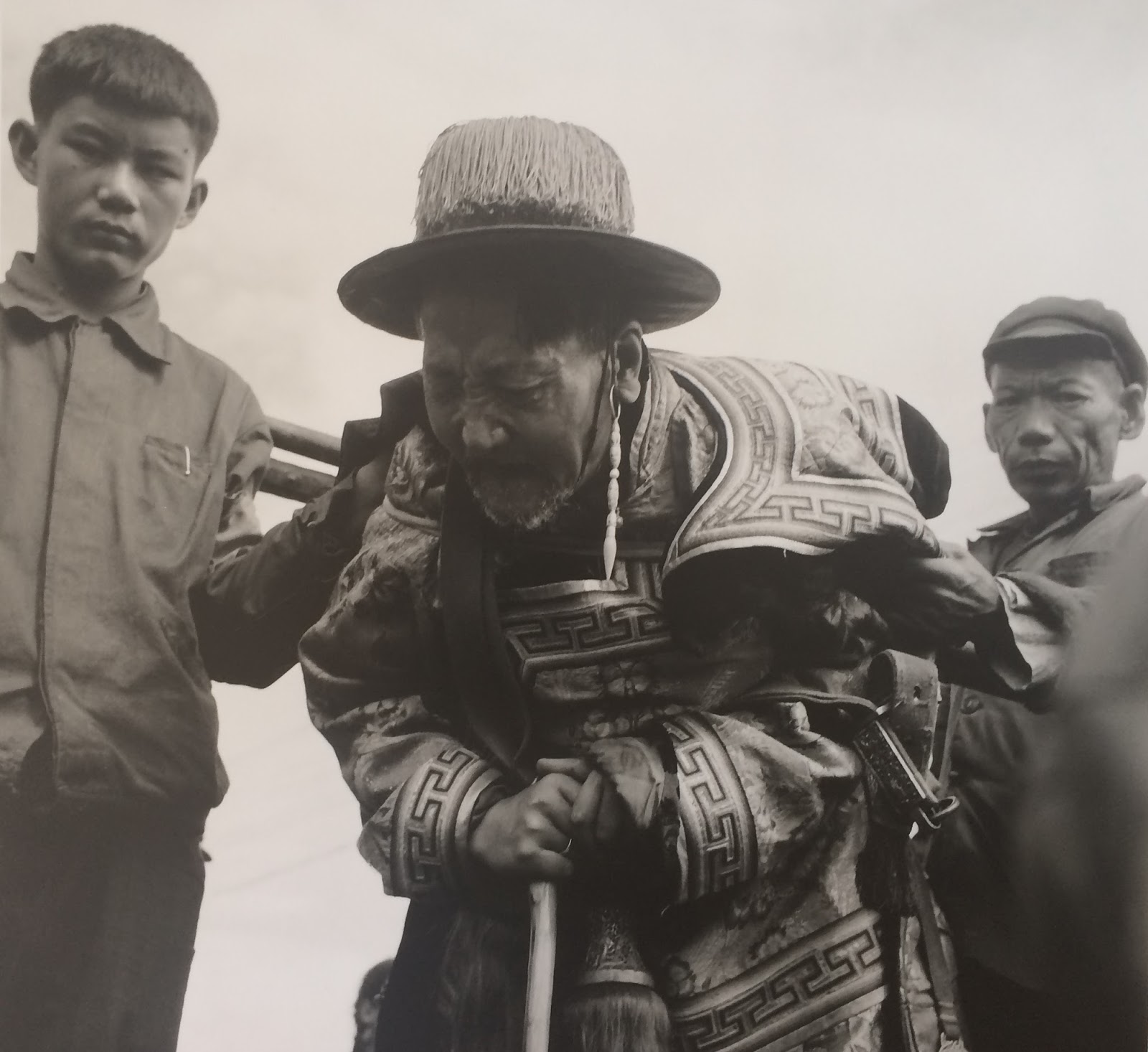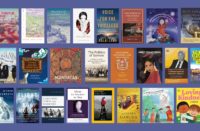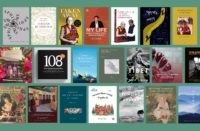
High Peaks Pure Earth has translated a blogpost by Woeser written in June 2015 for the Mandarin service of Radio Free Asia and published on her blog on June 23, 2015.
Despite the title, this blogpost is about a serious subject. Woeser has often in the past written about Tibet during the Cultural Revolution and the importance of remembering history.
For more background on the Sampo family, see their entry on Treasury of Lives: http://treasuryoflives.org/institution/Yabzhi-Sampo
For a biography of Tsering Dorjee, Woeser’s father, see the website of the Berlin International Literature Festival: http://www.literaturfestival.com/archive/participants/kuenstler/tsering-dorjee
“Nasal Mucus Erased by a German Photo Retoucher”
By Woeser

In the summer of 1966, the inferno of the Cultural Revolution burnt its way from Beijing to Lhasa. As a middle-ranking military officer, my father used his camera to record the damage inflicted upon Tibetan monasteries and Buddhist culture. Aristocrats, merchants, high-level monks and members of the original Tibetan government were publicly denounced, while lower-class Tibetans and young people from different social strata were brainwashed; the People’s Liberation Army implemented an iron-fist rule in the whole of Tibet. There are about 300 photos of this period; based on these photographs, I carried out interviews in Lhasa and other areas in Tibet and spent six years writing up my book “Forbidden Memory: Tibet During the Cultural Revolution” that was published in Taiwan in 2006. It gives readers around the world visual and textural insights into Tibetan experiences during the Cultural Revolution. 24 of these photographs were selected and exhibited at the Berlin International Literature Festival in 2012 and attracted a wide audience.
The theme of the festival was “The Visible and Invisible Prisons” (Die sichtbaren und die unsichtbaren Gefängnisse); the artists Ai Weiwei and Meng Huang, the writer Liao Yiwu, and the poet and wife of Liu Xiaobo, Liu Xia, also contributed to the event. My father was the only participant who is no longer with us; he was also the only “ethnic minority” and CCP military official; but he entered the exhibition as a photographer. Deutsche Welle reported: “Tsering Dorjee’s photographs are precious and unmatched pieces of historical evidence, providing invaluable information on Tibet during the Cultural Revolution”.
The images were provided by me, but enlarged, retouched and printed by the organisers. After the end of the exhibition, a friend took the exhibited photos back from Berlin to give them to me; the quality of the printing paper was excellent, and the design professional, much better than the photos developed by my father back then. There was only one photograph that left me in surprise; I could not help but laugh. Only after some time, I began to feel that there was more to it.
It is a photo that was taken in August 1966, showing a scene of the aristocrat Sampo Tsewang Rigzin being publicly denounced in Lhasa. His charge was “organising an armed rebellion, maintaining illicit relations with foreign countries, and being against the Party and against the proletarian dictatorship.” In reality, he had been cooperating with the intruders since 1950s, and obtained the empty-sounding title of second commander of the Tibetan military zone and become a major general of the PLA. As a “higher-level patriot”, during the so-called pacification of the rebellion in 1959, his name was found under a public notice propagating the suppression of “armed rebels” that the new regime disseminated.
In the 18th century, Sampo Tsewang Rigzin’s family rose to prominence because of the 7th Dalai Lama; they were the most respected Yabzhi aristocratic family. Sampo Tsewang Rigzin himself started his official career at the age of 15, assuming a series of posts within the Tibetan government. As we can see on this particular photo, the Red Guards and “enthusiasts” denouncing him made him wear apparel of a fourth or higher-ranking government official, making him look luxuriously dressed; this untimely outer appearance served as a reason to humiliate him. At the time, he was only 62 years old, but already using a walking stick and looking old and weak. On his back, he carries two wooden sticks, it is said that these were torture instruments. What is particularly eye-catching is the mucus coming out of Sampo Tsewang’s nose, an undignified and disgraceful image.
I used to look through the my father’s photos when I was very young and this photo left a deep impression because I never understood how an adult could be in such a devastating situation that mucus would come out of his nose in public. Later, I sarcastically wrote in an essay based on these photographs:
“The emancipated serfs stripped off their traditional Tibetan garments and put on green uniforms; even though they did not wear badges or caps, they basically turned into soldiers with red armbands. Their heads were burning and their faces bright red, they were sitting legs crossed on People’s Square in front of Potala Palace when a few revolutionary singers holding the “Little Red Book” passionately and full of pride began to shout in unison; they clenched their fists towards the class enemies that were herded up and publicly exposed on the square. The class enemies were forming a line, trembling with fear; their hands were tied together, they were forced to wear tall paper hats and big signs around their necks; this was especially true for those former tyrannical landlords; they were turned into clowns, wearing layers of outdated silk and satin, dragging along a wooden handcart loaded with buckets full of artefacts proving their guilt; their heads were low, their faces full of shame, many of them had tears and mucus dripping from their soiled faces, looking like long and thin threads suspending from their heads all the way onto the ground; some were wailing loudly.”
On the photograph showing Sampo Tsewang Rigzin’s denunciation that was exhibited at the Literature Festival in Berlin, however, the nasal mucus had completely vanished. The friend who brought the developed photos back to me laughed: the German retoucher thought it was a scratch on the old photo and got rid of it.
Modern computer technology has made retouching extremely effective, to the point that one is no longer able to even discern the slightest trace of the erased content. The shameful mucus was eradicated perhaps due to the kind-heartedness of the German retoucher. The young retoucher never experienced the brutality of the Cultural Revolution and could not imagine such indignity towards one single person. But even though the intention behind polishing this photograph was honourable, it actually made the end result inferior to the original; I wonder whether this erasure is not another kind of damage, albeit an understandable one?
The mucus on the original photo looked like a crack, a crack separating life into “new” and “old”, allowing us to take a glimpse at the rapid change of history; during this change, a once noble and important person suddenly found himself imprisoned. My point is not, however, that a person of low status could suddenly free himself and become a master; for example, the two Tibetan Red Guards who are denouncing Sampo Tsewang Rigzin on the photograph are by no means of high rank or great wealth; on the contrary, they have long been dead. In fact, when one’s homeland is already lost, every single person becomes a slave; when humiliated to such an extent, how can one control one’s body in public?!
Precisely because of the importance of the mucus, the retoucher who evidently meant well, actually harmed the photograph by erasing it and thus undermining the power of historical evidence and also historical truthfulness. I used to think that what happened could be explained by cultural differences between the east and the west, but now I have come to recognise that it is due to a different attitude towards memory. The simple act of retouching the photo may have made the image flawless, but the end result turned out to be inferior because a key memory was erased and the scope of this human tragedy has therefore been diluted. It is our duty to pay acute and meticulous attention to every single detail that happened back then; only then are we able to fully recover that memory; we must preserve every single bit of shame and humiliation or indeed, every single bit of nasal mucus.


These photos were also first published in
“Forbidden Memory: Tibet During the Cultural Revolution”
What I would like to add is that my father took two different photos. One showing Sampo Tsewang Rigzin and his wife being denounced in public. And another equally disgraceful one, showing Sampo Tsewang Rigzin’s wife covered in gold and silver pearls, holding a tray full of religious instruments, and carrying a traditional vessel used to weigh foodstuff on her back. The weight pushes her down to the point that her face almost hits the ground; her eyes are blankly staring at the ground, filled with deep despair. Sampo Tsewang Rigzin passed away in 1973; his wife died a little later. His older son was one of the five Tibetan government officials who had gone to Beijing in 1951 to sign the “17 Point Agreement”; he later spent almost 20 years in prison. His younger son was caught while trying to escape to India and accused of “treason”; he was not even 20 years old when he was executed in 1970. The entire family of Sampo Tsewang Rigzin, originally a cooperator with the CCP, was eventually wiped out.
June 2015





Follow Us!